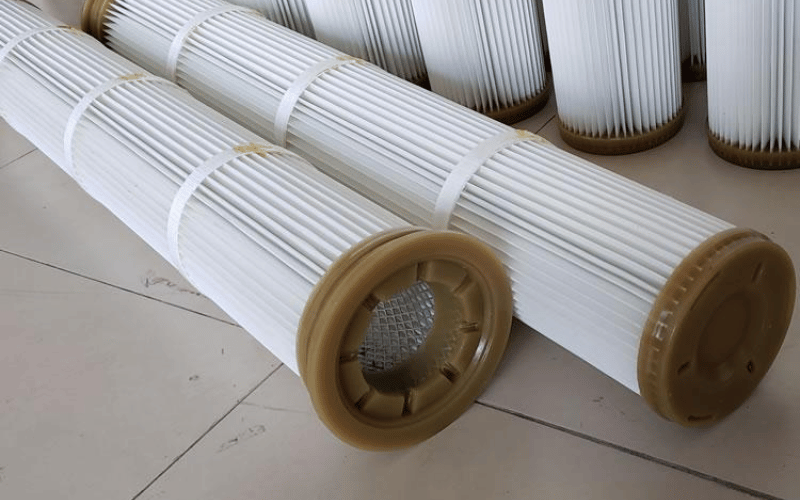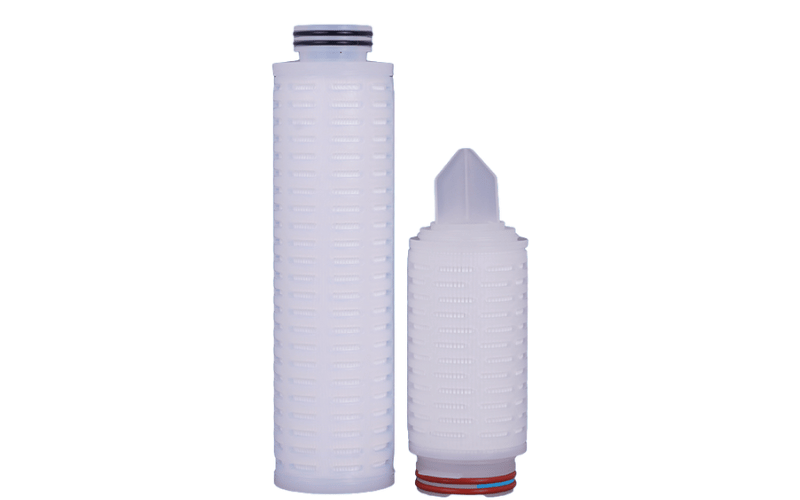Filtration systems are the unsung heroes of industrial operations, ensuring clean air, purified liquids, and contaminant-free processes across various sectors. Among the most efficient filtration solutions are pleated bag filters and cartridge filters—engineered to handle high-capacity filtration with precision and durability.
While the average person may not give much thought to how factories maintain air quality or how water treatment plants remove impurities, industries such as pharmaceuticals, food processing, and chemical manufacturing rely heavily on these advanced filtration systems.
So, what sets pleated bag filters apart from cartridge filters? How do they work, and where are they best applied? Let’s dive into the mechanics, materials, and key differences between these two essential filtration technologies.
Table of Contents
ToggleWhat are Pleated Bag Filters?
Pleated bag filters are filtration devices designed to remove particulates from air or liquid streams. Unlike standard bag filters, they feature pleated media, which increases the surface area for filtration without requiring additional space. Key characteristics include:
- Construction: Made from materials like polyester, polypropylene, or PTFE, pleated filters are engineered for durability and compatibility with various operating conditions.
- Design: The pleated structure enables a higher dust or particle-holding capacity, thereby reducing the frequency of replacements.
- Efficiency: These filters are capable of capturing fine particles, ensuring cleaner output in both air and liquid filtration systems.

Benefits of Using Pleated Bag Filters
The adoption of pleated bag filters offers several advantages over traditional filtration methods:
- Increased Surface Area: The pleated design maximizes filtration capacity, enabling higher flow rates and improved efficiency.
- Extended Lifespan: With greater dust-holding capacity, these filters require less frequent replacement, reducing maintenance costs.
- Versatility: Suitable for a wide range of applications, pleated bag filters can handle varying temperatures, pressures, and chemical exposures.
- Energy Efficiency: Lower pressure drops during operation contribute to reduced energy consumption in filtration systems.
Applications of Pleated Bag Filters
Pleated bag filters are utilized in numerous industries due to their adaptability and performance:
- Industrial Processes: Used in dust collection systems, chemical processing, and power plants to ensure clean air and efficient operations.
- Water Treatment: Effective in removing contaminants from water in municipal, industrial, and commercial settings.
- Pharmaceuticals and Food Processing: Ensures compliance with stringent hygiene and safety standards by filtering fine particles and impurities.
- HVAC Systems: Enhance air quality in residential, commercial, and industrial environments.
By combining efficiency, durability, and versatility, pleated bag filters have become a vital solution for achieving optimal filtration in diverse applications.
What Are Cartridge Filters?
Cartridge filters are a widely used filtration solution, valued for their efficiency, versatility, and ease of use. These filters are designed to remove contaminants from liquids or gases, ensuring cleaner outputs in various industrial and commercial applications. This section offers an in-depth examination of cartridge filters, highlighting their structure, benefits, and typical applications across multiple sectors.

Overview of Cartridge Filters
Cartridge filters are cylindrical filtration devices that use a replaceable filter element to trap particles and impurities. They are available in various materials and configurations to suit specific filtration needs. Key features include:
- Construction: Typically made from materials like polypropylene, polyester, or stainless steel, ensuring durability and compatibility with diverse operating conditions.
- Filtration Mechanism: They employ depth or surface filtration, depending on the application, to capture particles of varying sizes.
- Ease of Replacement: The modular design allows for quick and simple replacement of filter cartridges, minimizing downtime.
Advantages of Cartridge Filters
Cartridge filters offer several benefits that make them a preferred choice for many filtration systems:
- High Filtration Efficiency: Capable of removing fine particles, ensuring superior filtration performance.
- Customizability: Available in different sizes, materials, and micron ratings to meet specific requirements.
- Compact Design: Their small footprint makes them ideal for systems with limited space.
- Cost-Effectiveness: Long service life and low maintenance requirements reduce overall operational costs.
- Versatility: Suitable for a wide range of applications, from water purification to chemical processing.
Common Uses for Cartridge Filters
Cartridge filters are employed in numerous industries due to their adaptability and effectiveness:
- Water Treatment: Used in municipal and industrial systems to remove sediments, chlorine, and other impurities.
- Food and Beverage: Ensures product quality by filtering out contaminants during production processes.
- Pharmaceuticals: Maintains sterility and purity in drug manufacturing by removing fine particles and microorganisms.
- Industrial Applications: Utilized in oil and gas, chemical processing, and power generation to protect equipment and ensure process efficiency.
By combining efficiency, flexibility, and ease of use, cartridge filters have become an essential component in achieving reliable and effective filtration across various industries.
Pleated Bag Filters vs. Cartridge Filters: Key Differences
| Feature | Pleated Bag Filters | Cartridge Filters |
|---|---|---|
| Design | Pleated fabric bags in a rigid frame | Cylindrical, often with a core for structural support |
| Filtration Efficiency | Suitable for larger particles (5+ microns) | Excellent for fine particles (down to 0.1 microns) |
| Surface Area | High (due to pleats) | Very high (especially in depth filters) |
| Maintenance | Shake down or replace when clogged | Replaceable cartridges (some cleanable) |
| Best For | High-volume air/dust filtration | High-precision liquid/gas filtration |
When to Choose Which?
- Pleated Bag Filters – Ideal for dust collection, HVAC, and bulk material handling where large volumes of air need filtering with minimal pressure drop.
- Cartridge Filters – Best for ultra-fine filtration in pharmaceuticals, food & beverage, and critical liquid processes.
Material Considerations: Which Media Works Best?
Both filter types come in various materials, each suited for different conditions:
1. Polyester (PET)
- Pros: Cost-effective, good chemical resistance.
- Cons: Limited temperature tolerance (~150°C).
- Uses: General dust collection, HVAC.
2. Polypropylene (PP)
- Pros: Resistant to acids and alkalis, hydrophobic (repels water).
- Cons: Not suitable for high temperatures.
- Uses: Water filtration, food processing.
3. PTFE (Teflon®)
- Pros: Extreme chemical & temperature resistance (up to 260°C).
- Cons: Expensive.
- Uses: Harsh chemical filtration, high-heat environments.
4. Stainless Steel Mesh
- Pros: Reusable, durable, handles high temperatures.
- Cons: Less efficient for fine particles.
- Uses: Oil filtration, abrasive material handling.
Frequently Asked Questions about Pleated Bag Filters and Cartridge Filters
What are pleated bag filters, and why are they used?
Pleated bag filters are advanced filtration solutions designed to capture industrial dust and particles. Their pleated structure increases the surface area, enabling higher dust retention and improved efficiency compared to traditional flat filters. They are widely used in baghouse dust collectors and other systems where high dirt-holding capacity is critical.
How do pleated cartridge filters differ from traditional filters?
Pleated cartridge filters provide superior filtration efficiency due to their expanded surface area. This design supports better airflow and lower pressure drops, allowing them to handle more dust without frequent replacements. Additionally, pleated cartridges are available in materials like spunbond polyester or polypropylene, making them adaptable to various applications.
What materials are pleated filters typically made from?
Pleated filters are commonly made from materials such as polyester, polypropylene, and PTFE membranes. These materials offer durability, resistance to abrasion, and suitability for high-temperature or demanding industrial environments.
Why is filter surface area important in pleated filters?
The surface area of a filter directly impacts its efficiency and dirt-holding capacity. A larger surface area captures more particles, resulting in higher dust retention and extended filter life. Pleated designs maximize surface area within the same physical space, enhancing overall performance.
Can pleated bag filters and cartridge filters be used interchangeably?
While both types serve similar filtration purposes, they are not always interchangeable. The choice depends on factors such as the type of dust, the required filtration area, and the design of the dust collection system. Selecting the appropriate filter ensures optimal performance and system compatibility.
What are the benefits of bottom-load versus top-load pleated filters?
Bottom-load pleated filters are easier to install and maintain, allowing for quick replacements without disrupting the system. Top-load filters, on the other hand, are better suited for applications with limited space. The choice depends on the design and operational requirements of the dust collector.
How often should pleated filters be replaced?
The replacement frequency depends on factors such as dust type, airflow, and application conditions. Monitoring pressure drop and dirt accumulation helps determine when replacement is necessary. Filters with larger surface areas generally last longer, reducing the need for frequent changes.
What are bag-sized pleated cartridge filters and their advantages?
Bag-sized pleated cartridge filters combine the compact size of bag filters with the efficiency of pleated designs. They fit standard baghouse systems while offering high dirt retention and effective dust control. Their versatility makes them ideal for a range of industrial applications.
How does airflow affect the efficiency of pleated filters?
Airflow is crucial for the performance of pleated filters. Proper airflow ensures effective particle capture without excessive pressure drop. Maintaining an optimal air-to-cloth ratio maximizes filtration efficiency and extends the filter’s service life.
The Bottom Line
Choosing between pleated bag filters and cartridge filters depends on your specific filtration needs—whether it’s high-volume air cleaning or ultra-fine liquid purification. Pleated bag filters excel in industrial dust control, while cartridge filters offer precision in critical applications, such as those in the pharmaceutical and food safety industries.
By understanding their differences, materials, and optimal use cases, industries can maximize efficiency, reduce downtime, and maintain cleaner operations. Whether you’re managing a manufacturing plant or a water treatment facility, selecting the right filtration system ensures peak performance and long-term cost savings.
Invest in the right filter today, because clean processes lead to better products and a safer environment.


